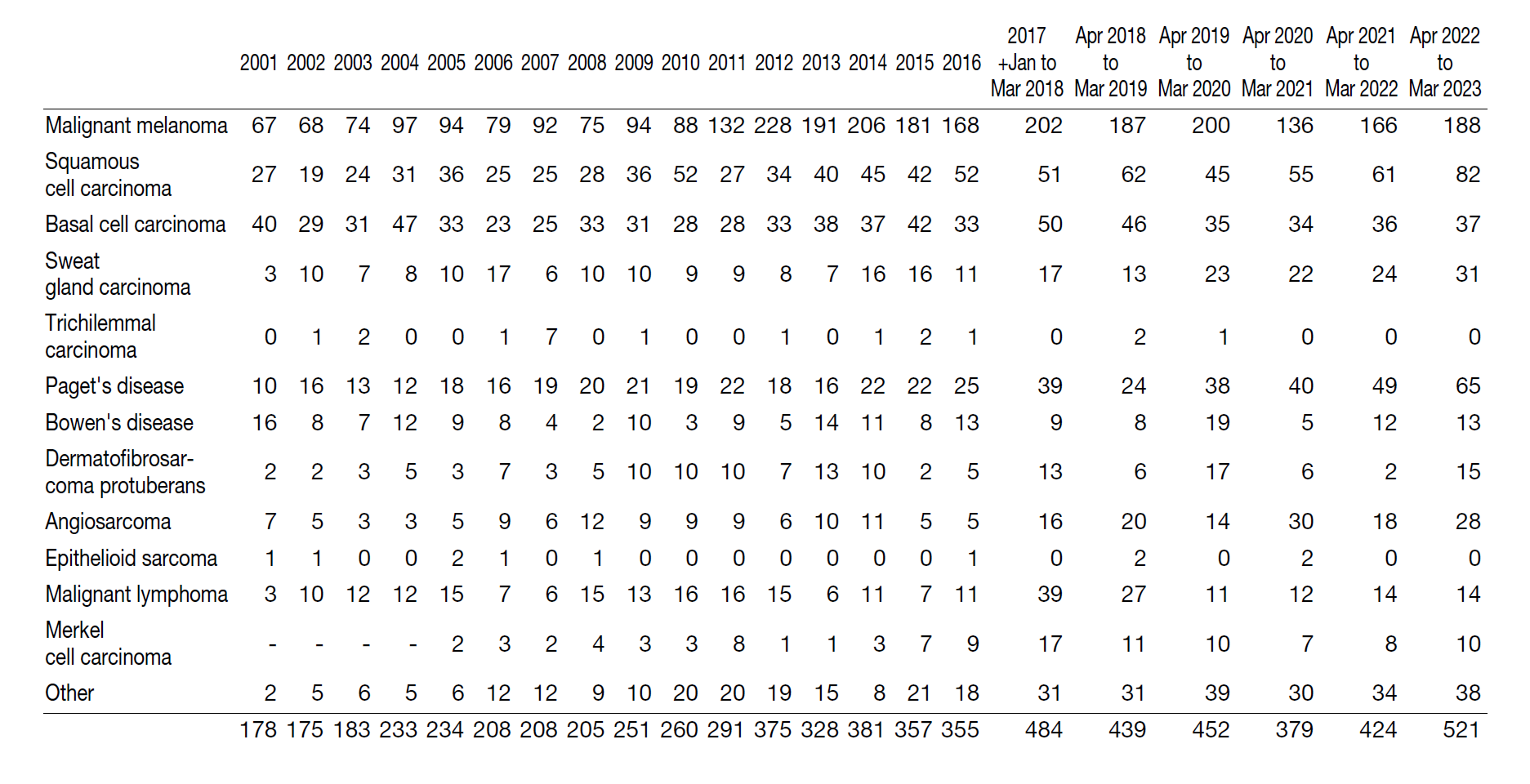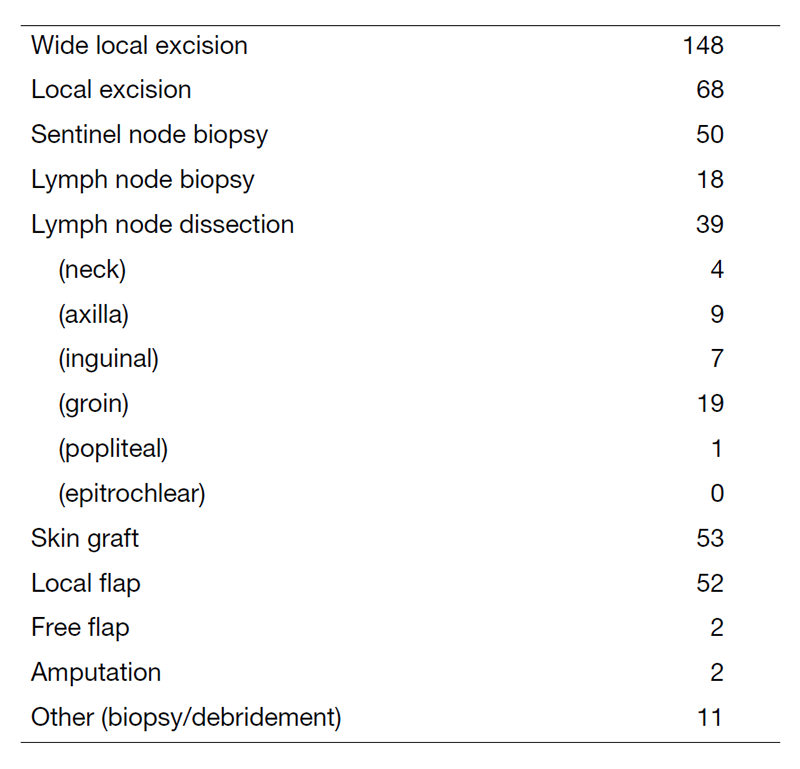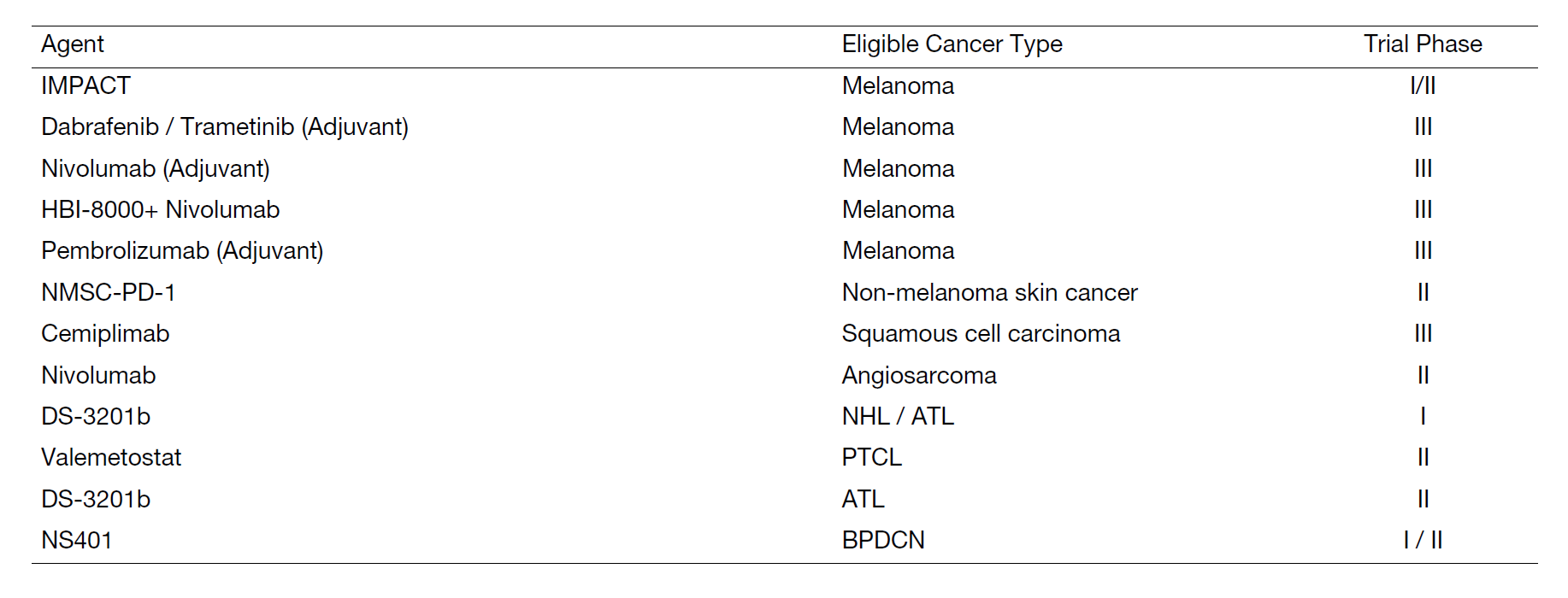Annual Report 2022
Department of Dermatologic Oncology
Naoya Yamazaki, Kenjiro Namikawa, Dai Ogata, Eiji Nakano, Kojiro Hiki
Introduction
The Department of Dermatologic Oncology has consistently served as the core hospital for the establishment of treatment strategies for malignant skin tumors since the National Cancer Center opened in 1962, and thus far, over 4,000 cases of malignant melanoma have been accumulated, an impressive number for a hospital or research institution in Japan. Today, patients are referred from throughout Japan. Most of the patients are examined and treated for skin cancer including malignant melanoma. Surgery is the main treatment modality for skin cancer, and multidisciplinary treatments, consisting of immunotherapy, targeted therapy, chemotherapy, and radiotherapy, are also routinely performed. However, currently, the importance of immunotherapy is increasing. Melanoma is at the center of the development of immune therapy. This department plays an active role in multicenter trials for new agents for skin cancer all over Japan.
The Team and What We Do
The department has four staff dermatologic oncologists, one chief resident and five residents. Our department is a high-volume center, where we have seen an average of 170 patients with malignant melanoma annually in the last 5 years (Table 1). At all times, approximately 14 patients are hospitalized to undergo surgery, chemotherapy, or radiation therapy. In 2022, 254 operations were performed including 143 operations under general anesthesia (Table 2). This is the result of the creation of a national network to develop treatment for malignant skin tumors, and nivolumab, an anti-PD-1 antibody, was previously approved as a therapeutic agent for malignant melanoma in Japan for the first time in the world as a result of vigorous development of new drugs.
Table 1. Number of New Patients

Table 2. Operative Procedures (Total Number) in April 2022 to March 2023

Rounds are conducted and case presentations are held every morning. A department conference is held every Monday to discuss the therapeutic principles for outpatients and inpatients. A clinicopathological conference highlighting on surgically removed skin specimens is held with pathologists once a month.
In addition, we have treated advanced cases of mucosal melanoma in the nasal cavity, genital lesions, perianal lesions, and uveal melanoma although our origins are “dermatologic”.
We are currently participating in an international joint research on acral and mucosal melanoma on behalf of institutions in Asia. In particular, we believe that first-line drug treatment options for BRAF-positive melanoma are different from those at Western facilities.
This year as well, our hospital was affected by COVID-19 and the number of patients was slightly lower. Nevertheless, we are actively disseminating information regarding treatments for rare cancers such as angiosarcoma and extramammary Paget's disease.
Research Activities
In recent years, several new drugs have been developed rapidly overseas for the treatment of malignant melanoma, and our department is conducting many clinical studies and trials for all skin cancers; the major ones are described below.
- Effectiveness and safety of nivolumab and ipilimumab combination therapy in 100 Japanese patients with advanced melanoma.
- A comfirmatory trial of non-amputative digit preservation surgery for subungual melanoma. (JCOG1602; J-NAIL study)
- A single-arm confirmatory trial of pazopanib in patients with paclitaxel-pretreated primary cutaneous angiosarcoma. (JCOG1605)
- Prognoses of patients with melanoma who continue/discontinue anti-PD-1 antibody monotherapy after achieving a complete response in a retrospective study.
- Treatment outcomes and prognostic factors in patients with primary anorectal malignant melanoma in the immune therapy.
- Efficacy comparison between anti-PD-1 antibody monotherapy and anti-PD-1 plus anti-CTLA-4 combination therapy as first-line immunotherapy for patients with advanced acral melanoma: a retrospective multicenter study.
- Confirmatory trial of narrower side margin excision for basal cell carcinoma in Japanese population. (JCOG2005)
- Analysis of circulating tumor DNA by blood screening of patients with malignant melanoma.
- Malignant melanoma treatment using brachytherapy.
- Postoperative radiation therapy improves prognoses in patients with extramammary Paget’s disease presenting with multiple lymph node metastases.
Clinical Trials
Table 3 presents a summary of our clinical trials.
Table 3. New Agent Studies in 2022

Education
Currently, training in routine clinical practice under skilled guidance is ongoing for one chief resident and five resident physicians. In addition, conferences with the departments of oncology, radiotherapy and pathology are held on a regular basis. The trainees made a total of 22 presentations in domestic academic conferences, and published eleven papers; nine of them were international academic papers in English.
Future Prospects
With continuous progress in drug therapy for advanced cutaneous malignant melanoma, we are now facing an era where the indications of drug therapy for rare types of malignant melanoma are being expanded to include combination and neoadjuvant therapies based on international multicenter studies.
Meanwhile, we are developing treatments for advanced squamous cell carcinoma and angiosarcoma using immune checkpoint inhibitors.
In addition to these, the Department of Radiation Oncology is developing a linear accelerator for the hospital-based boron neutron capture therapy (BNCT) as a new radiotherapy. We are participating in a phase II trial for angiosarcoma.
List of papers published in 2022
Journal
1. Hiki K, Ogata D, Hisada I, Sakamoto T, Hiroyuki T, Yamakawa K, Namikawa K, Takahashi A, Saito Y, Yamazaki N. Minimally invasive surgery combined with excision and endoscopic submucosal dissection for anorectal melanoma. The Journal of dermatology, 50:e26-e27, 2023
2. Ogata D, Tsutsui K, Namikawa K, Moritani K, Nakama K, Jinnai S, Takahashi A, Tsukamoto S, Kanemitsu Y, Yamazaki N. Treatment outcomes and prognostic factors in 47 patients with primary anorectal malignant melanoma in the immune therapy era. Journal of cancer research and clinical oncology, 149:749-755, 2023
3. Yamakawa K, Ogata D, Hiki K, Jinnai S, Namikawa K, Takahashi A, Yamazaki N. Metastatic basal cell carcinoma with a high tumor mutational burden that achieved complete response with pembrolizumab. International journal of dermatology, 62:e79-e80, 2023
4. Ishiguro A, Ogata D, Okuma K, Kashihara T, Murakami N, Hiki K, Yamakawa K, Jinnai S, Takahashi A, Namikawa K, Igaki H, Yamazaki N. Malignant melanoma treatment using brachytherapy: Two case reports and 15 case series. The Journal of dermatology, 50:94-97, 2023
5. Kashihara T, Ogata D, Okuma K, Nakamura S, Nakayama H, Mori T, Takahashi A, Namikawa K, Takahashi A, Takahashi K, Kaneda T, Inaba K, Murakami N, Okamoto H, Nakayama Y, Yamazaki N, Igaki H. Clinical significance of local control of primary tumour in definitive radiotherapy for scalp angiosarcomas. Skin research and technology, 29:e13243, 2023
6. Kaku S, Horinouchi H, Watanabe H, Yonemori K, Okusaka T, Boku N, Yamazaki N, Kawai A, Ohe Y, Kusumoto M. Incidence and prognostic factors in severe drug-induced interstitial lung disease caused by antineoplastic drug therapy in the real world. Journal of cancer research and clinical oncology, 148:1737-1746, 2022
7. Ohe Y, Yamazaki N, Yamamoto N, Murakami H, Yoh K, Kitano S, Hashimoto H, Murayama A, Nakane S, Gemma A. The real-world safety of atezolizumab as second-line or later treatment in Japanese patients with non-small-cell lung cancer: a post-marketing surveillance study. Japanese journal of clinical oncology, 52:623-632, 2022
8. Ida H, Koyama T, Mizuno T, Sunami K, Kubo T, Sudo K, Tao K, Hirata M, Yonemori K, Kato K, Okusaka T, Ohe Y, Matsui Y, Yamazaki N, Ogawa C, Kawai A, Narita Y, Esaki M, Yamamoto N. Clinical utility of comprehensive genomic profiling tests for advanced or metastatic solid tumor in clinical practice. Cancer science, 113:4300-4310, 2022
9. Kikuchi K, Yamazaki N, Nozawa K, Fukuda H, Shibata T, Machida R, Hamaguchi T, Takashima A, Shoji H, Boku N, Takatsuka S, Takenouchi T, Nishina T, Yoshikawa S, Takahashi M, Hasegawa A, Kawazoe A, Masuishi T, Mizutani H, Kiyohara Y. Topical corticosteroid therapy for facial acneiform eruption due to EGFR inhibitors in metastatic colorectal cancer patients: a randomized controlled trial comparing starting with a very strong or a weak topical corticosteroid (FAEISS study, NCCH1512, colorectal part). Supportive care in cancer, 30:4497-4504, 2022
10. Okumura M, Nakano E, Namikawa K, Takahashi A, Fujiwara Y, Yamazaki N. Efficacy of surgery for skin cancers initially suspected to be carcinoma of unknown primary: a retrospective observational study. International journal of dermatology, 61:e150-e152, 2022
11. Kiyohara E, Tanemura A, Sakura K, Nakajima T, Myoui A, Yamazaki N, Kiyohara Y, Katayama I, Fujimoto M, Kaneda Y. A phase I dose-escalation, safety/tolerability, and preliminary efficacy study of the intratumoral administration of GEN0101 in patients with advanced melanoma. Cancer immunology, immunotherapy, 71:2041-2049, 2022
12. Jinnai S, Namikawa K, Takahashi A, Ogata D, Yamazaki N. Incidence and patterns of lymphatic drainage to the epitrochlear and popliteal sentinel lymph nodes in malignant melanoma of the distal extremities: a single-institution retrospective study. International journal of dermatology, 61:855-860, 2022
13. Kato J, Namikawa K, Uehara J, Nomura M, Nakamura Y, Uhara H, Uchi H, Yoshikawa S, Kiniwa Y, Nakamura Y, Miyagawa T, Matsushita S, Takenouchi T, Hatta N, Ohno F, Maeda T, Fukushima S, Yamazaki N. Prognoses of patients with melanoma who continue/discontinue anti-programmed death-1 therapy after achieving a complete response in a real-world setting: a multicentre retrospective study. The British journal of dermatology, 187:594-596, 2022
14. Kamimura A, Nakamura Y, Takenouchi T, Matsushita S, Omodaka T, Yamamura K, Uchi H, Yoshikawa S, Yanagisawa H, Ito T, Kiyohara Y, Nakamura Y, Aoki M, Ishizuki S, Oashi K, Miyagawa T, Maeda T, Ogata D, Hatta N, Ohe S, Isei T, Takahashi A, Umeda Y, Yamaguchi B, Ishikawa M, Horimoto K, Fujsawa Y, Uehara J, Shibayama Y, Kiniwa Y, Kawahara Y, Matsuya T, Uhara H, Kato J, Nakamura Y, Murakami T, Namikawa K, Yoshino K, Funakoshi T, Takatsuka S, Matsui Y, Sasaki J, Koga H, Yokota K, Komori T, Fukushima S, Yamazaki N. Concordance in judgment of clinical borders of basal cell carcinomas in Japanese patients: A preliminary study of JCOG2005 (J-BASE-MARGIN). The Journal of dermatology, 49:837-844, 2022
15. Uhara H, Tsuchida T, Kiyohara Y, Akamatsu A, Sakamoto T, Yamazaki N. Safety and effectiveness of nivolumab in Japanese patients with malignant melanoma: Final analysis of a post-marketing surveillance. The Journal of dermatology, 49:862-871, 2022
16. Yamazaki N, Isei T, Kiyohara Y, Koga H, Kojima T, Takenouchi T, Yokota K, Namikawa K, Yi M, Keegan A, Fukushima S. A phase I study of the safety and efficacy of talimogene laherparepvec in Japanese patients with advanced melanoma. Cancer science, 113:2798-2806, 2022
17. Dimitriou F, Namikawa K, Reijers ILM, Buchbinder EI, Soon JA, Zaremba A, Teterycz P, Mooradian MJ, Armstrong E, Nakamura Y, Vitale MG, Tran LE, Bai X, Allayous C, Provent-Roy S, Indini A, Bhave P, Farid M, Kähler KC, Mehmi I, Atkinson V, Klein O, Stonesifer CJ, Zaman F, Haydon A, Carvajal RD, Hamid O, Dummer R, Hauschild A, Carlino MS, Mandala M, Robert C, Lebbe C, Guo J, Johnson DB, Ascierto PA, Shoushtari AN, Sullivan RJ, Cybulska-Stopa B, Rutkowski P, Zimmer L, Sandhu S, Blank CU, Lo SN, Menzies AM, Long GV. Single-agent anti-PD-1 or combined with ipilimumab in patients with mucosal melanoma: an international, retrospective, cohort study. Annals of oncology, 33:968-980, 2022
18. Okumura M, Ogata D, Namikawa K, Tsutsui K, Takahashi A, Okuma K, Kashihara T, Igaki H, Akiyama M, Yamazaki N. Postoperative radiation therapy improves prognoses in extramammary Paget’s disease presenting with multiple lymph node metastases. The Journal of dermatology, 49:1005-1011, 2022
19. Dummer R, Flaherty KT, Robert C, Arance A, de Groot JWB, Garbe C, Gogas HJ, Gutzmer R, Krajsová I, Liszkay G, Loquai C, Mandalà M, Schadendorf D, Yamazaki N, di Pietro A, Cantey-Kiser J, Edwards M, Ascierto PA. COLUMBUS 5-Year Update: A Randomized, Open-Label, Phase III Trial of Encorafenib Plus Binimetinib Versus Vemurafenib or Encorafenib in Patients With BRAF V600-Mutant Melanoma. Journal of clinical oncology, 40:4178-4188, 2022
20. Yamazaki N, Shimizu A, Ozaki M, Hamada M, Takeuchi N, Ito Y, Maekawa S. Real-world safety and effectiveness of pembrolizumab in Japanese patients with radically unresectable melanoma: An all-case postmarketing surveillance in Japan. The Journal of dermatology, 49:1096-1105, 2022
21. Ishiguro A, Ogata D, Ohashi K, Hiki K, Yamakawa K, Jinnai S, Tsutsui K, Takahashi A, Namikawa K, Yamazaki N. Type 1 diabetes associated with immune checkpoint inhibitors for malignant melanoma: A case report and review of 8 cases. Medicine, 101:e30398, 2022
22. Nakamura Y, Namikawa K, Kiniwa Y, Kato H, Yamasaki O, Yoshikawa S, Maekawa T, Matsushita S, Takenouchi T, Inozume T, Nakai Y, Fukushima S, Saito S, Otsuka A, Fujimoto N, Isei T, Baba N, Matsuya T, Tanaka R, Kaneko T, Onishi M, Kuwatsuka Y, Nagase K, Onuma T, Nomura M, Umeda Y, Yamazaki N. Efficacy comparison between anti-PD-1 antibody monotherapy and anti-PD-1 plus anti-CTLA-4 combination therapy as first-line immunotherapy for advanced acral melanoma: A retrospective, multicenter study of 254 Japanese patients. European journal of cancer (Oxford, England : 1990), 176:78-87, 2022
23. Kato T, Matsubara N, Shiota M, Eto M, Osawa T, Abe T, Shinohara N, Yasumizu Y, Tanaka N, Oya M, Nishimoto K, Hayashi T, Nakayama M, Kojima T, Namikawa K, Fujisawa T, Okano S, Hida E, Nakamura Y, Bando H, Yoshino T, Nonomura N. IMAGENE trial: multicenter, proof-of-concept, phase II study evaluating the efficacy and safety of combination therapy of niraparib with PD-1 inhibitor in solid cancer patients with homologous recombination repair genes mutation. BMC cancer, 22:1292, 2022
24. Mizuta H, Ogata D, Jinnai S, Namikawa K, Takahashi A, Yamazaki N. Pathological complete response to preoperative avelumab treatment in a patient with advanced Merkel cell carcinoma. Dermatology online journal, 28:2022
25. Kaku S, Horinouchi H, Watanabe H, Yonemori I(, Okusaka T, Boku N, Yamazaki N, Kawai A, Ohe Y, Kusumoto M. Correction to: Incidence and prognostic factors in severe druginduced interstitial lung disease caused by antineopiastic drug therapy in the real world. J Cancer Res Clin Oncol;148(7) :I7 47 .2022.
